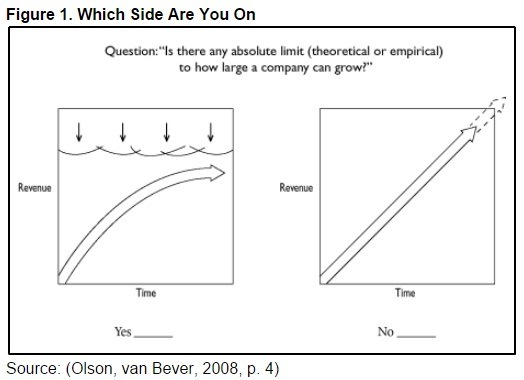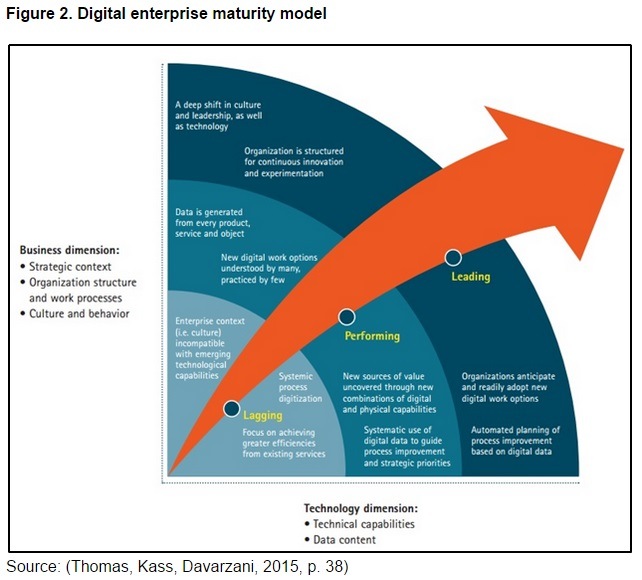Shawn Collinson, Chief Strategy Officer at Accenture’s Institute for High Performance and Technology Labs, identifies five success criteria for 2015 in his article ‘From Looking Digital to Being Digital.’ Accenture can evaluate its impact of technology on the future work by exploring these five areas: Strategic content, technical capabilities, data content, organizational structure and work processes and culture and behavior (Thomas, Kass, Davarzani, 2015, p. 38). These five areas are visually represented in Figure 1 below in the digital enterprise maturity model.

Three categories of performance. A thumbnail evaluation can be made to establish competency and potential for future growth taking a cross section of the five areas aligned into three categories: lagging, performing or leading illustrated in Table 1 (Thomas, Kass, Davarzani, 2015, p. 39).
When are decisions made? Where is the work located? What skills required? These are all questions Robert Thomas, Managing Director with Accenture, posed to management and then answered. The focus is moving from employer to consumer.
Link the value of business with technical value. We witnessed this with the shift in private-sector employer-provided retirement plans from defined benefit plans to defined contribution plans, and are observing this again with social engagement of consumer electronics and the previously conventional retail players like Nike that are selling less shoes and more software. The digital enterprise maturity model (see Figure 2.) promotes the value of business (strategic, culture and behavior) synchronized with technical value (technical capabilities and creating actionable steps from information). The more tightly coupled this alignment the closer the organization is to world class results.
Dynamic decisions are everything. Strategic content is important as this drives ‘edge-centric decision making’ where decisions are made at the level where the more knowledge resides. Typically this knowledge of context impacts pricing and product or service designs and is increasingly at a lower level in the organizational structure. This data based decision making accounts for ‘real-time adaptation.’ Knowledge of the foundational elements of the business, armed with real-time information positions Accenture to adapt to change leading to more dynamic decision making.
People are the most important asset. During the 2014 Gartner CIO Symposium, analysts launched the Digital Humanist Manifesto, outlined in Figure 3. The future is not people, technology, or things. The future is the intersection amidst people, technology, and things. What makes this model sticky is putting people at the center. Every asset of value in an organization links back to its people and Accenture was aware of this.

Center decisions around your customer. We as leaders must introduce new ideas for management including human and digital recombination, experiment-driven design, developing and deploying the right talent, employing the right tools in the right way, evolving the right management mindset and building a path to intelligent digital processes. What is common about these areas is that people are in the center- their employees and their customers.
“The message is clear: if data is the raw asset, it must be available to those who can turn it into information, knowledge and value” (Thomas, Kass, Davarzani, 2015, p. 34). Leaders have to anticipate change and build a culture and organizational behavior that embraces uncertainty putting people first. This shift will result in advanced decision making and moving employees from ‘order takers’ to ‘weather forecasters.’
As you run, grow and transform your business take time to incorporate digital humanism. Without digital humanism, there is no consumer engagement.
Strategic focus supported by business and technical capabilities realigns strategic priorities with individual, team and organizational objectives. This alignment generates long term customer focused value, propelled by an organization investing in their people; their most important asset.
References
Ballard, B. (2014). Gartner Symposium 2014: CIOs need to embrace digital humanism to put people first | ITProPortal.com (online image). Retrieved from http://www.itproportal.com/2014/11/10/gartner-symposium-2014-cios-need-embrace-digital-humanism-put-people-first/
Thomas, R. J., Kass, A., & Davarzani, L. (2015). Accenture: From Looking Digital to Being Digital – Accenture. Retrieved from http://www.accenture.com/SiteCollectionDocuments/PDF/Accenture-Impact-of-Technology-April-2014.pdf
Thomas, R. J., Kass, A., & Davarzani, L. (2015). Accenture: From Looking Digital to Being Digital – Accenture (online image). Retrieved from http://www.accenture.com/SiteCollectionDocuments/PDF/Accenture-Impact-of-Technology-April-2014.pdf
ZDnet. (2014). The next big tech gig: Digital humanist (online image). Retrieved June 16, 2015, from http://www.zdnet.com/article/the-next-big-tech-gig-digital-humanist/

